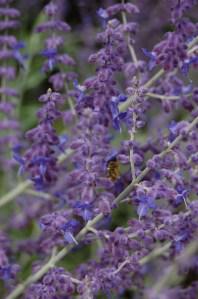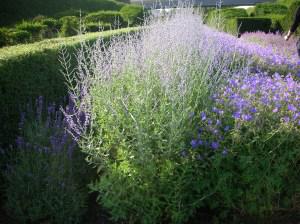
Perovskia atriplicifolia flower (10/07/2011, London)
Position: Full sun
Soil: Well drained soil
Flowering period: Summer and autumn
Eventual Height: 1.2m
Eventual Spread: 1m
Hardiness: USDA Zone 5a-9b
Family: Lamiaceae
Perovskia atriplicifolia is a deciduous sub-shrub with an upright habit. Its grey-white stems bear narrowly ovate and coarsely toothed leaves, which are fragrant when crushed. From summer to mid autumn it bears double lipped, violet blue, monoecious flowers in long slender spikes.
P. atriplicifolia, commonly known as Russian Sage, is native to many parts of central Asia including Afghanistan, Iran, Pakistan, and Tibet. Its flowers have been traditionally eaten fresh in salads and it also has a long history as a medicinal herb used to treat many illnesses such as diabetes, dysentery and in the reduction of fevers.
Perovskia was named for General Vasily Alekseevich Perovski (1794-1857), a 19th century imperial Russian general and statesman, with atriplicifolia being a Latinised word meaning that its foliage is similar to that of members of the Atriplex genus.

Perovskia atriplicifolia (01/07/2009, London)
This plant may be useful to the landscape architect as a low maintenance, aromatic flowering plant. It is also drought tolerant and suitable for xeriscaping.
The Royal Horticultural Society gave the cultivar Perovskia ‘Blue Spire’ their prestigious Award of Garden Merit in 1993 and reconfirmed its status in 2001.
This plant will tolerate almost any soil conditions; it will be happy at neutral, acid or alkaline pH levels, in loam, clay, chalk or sand based soils facing any sheltered or exposed aspect. It is also drought tolerant once established.
Ecologically this plant will attract various species pollinating insects such as butterflies and honey bees.
Maintenance: This plant requires little to no maintenance. Dead or damaged material may be removed in early spring and pruning back to near the woody framework may improve flowering.

